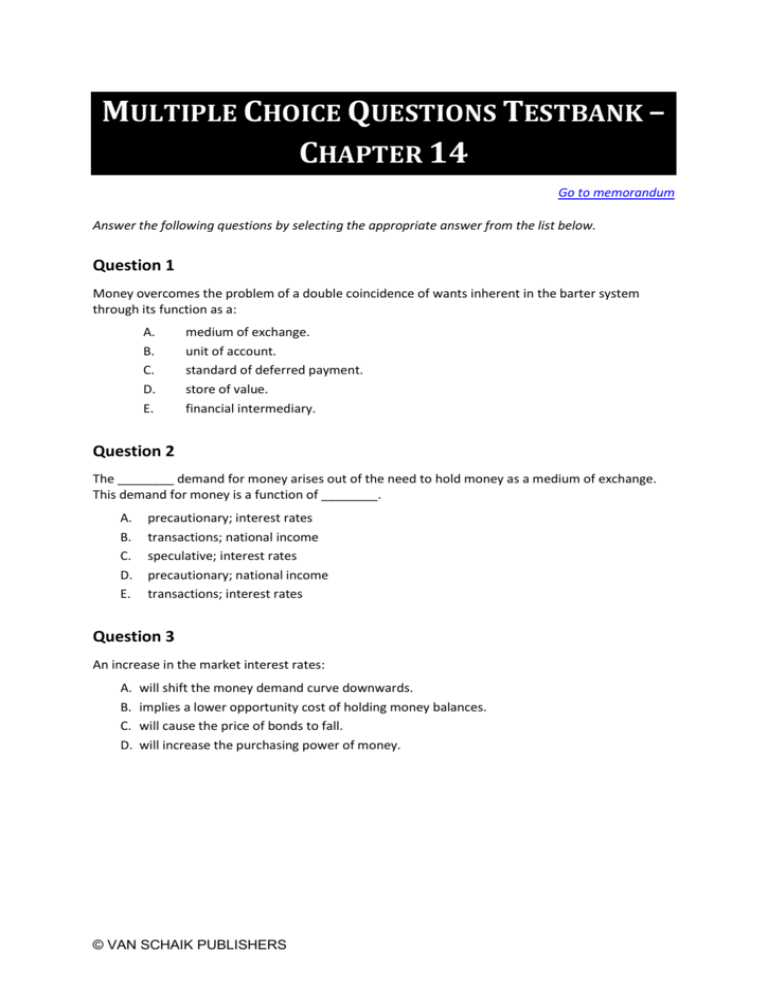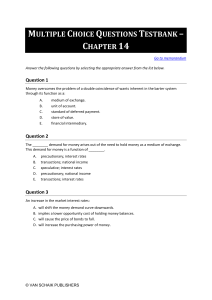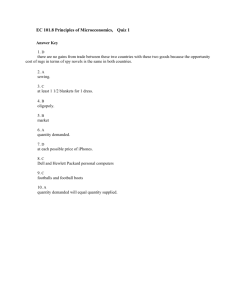Multiple Choice Questions Testbank – Chapter 14 Go to memor
advertisement

MULTIPLE CHOICE QUESTIONS TESTBANK – CHAPTER 14 Go to memorandum Answer the following questions by selecting the appropriate answer from the list below. Question 1 Money overcomes the problem of a double coincidence of wants inherent in the barter system through its function as a: A. B. C. D. E. medium of exchange. unit of account. standard of deferred payment. store of value. financial intermediary. Question 2 The ________ demand for money arises out of the need to hold money as a medium of exchange. This demand for money is a function of ________. A. B. C. D. E. precautionary; interest rates transactions; national income speculative; interest rates precautionary; national income transactions; interest rates Question 3 An increase in the market interest rates: A. B. C. D. will shift the money demand curve downwards. implies a lower opportunity cost of holding money balances. will cause the price of bonds to fall. will increase the purchasing power of money. © VAN SCHAIK PUBLISHERS Question 4 A decrease in the rate of interest: A. lowers the opportunity cost of money and leads to an increase in the quantity of money demanded. B. raises the opportunity cost of money and leads to an increase in the quantity of money demanded. C. lowers the opportunity cost of money and leads to a decrease in the quantity of money demanded. D. raises the opportunity cost of money and leads to a decrease in the quantity of money demanded. E. does not affect the quantity of money demanded. Question 5 Which one of the following statements is NOT true? A. B. C. D. E. Money is a unit of account. Money is a store of value. Money is a medium of exchange. Money is another term for income. Money is the most liquid asset. Question 6 Which of the following best describes the M1 measure of the money stock? A B. C. D. E. It is the M3 money measure minus the M2 money measure. M1 includes cash and medium term deposits. M1 is cash plus demand deposits. M1 is cash minus demand deposits. M1 is the most comprehensive measure of money stock available. Question 7 Which of the following is true of the money market? A. B. C. D. E. The speculative demand for money is a function of the interest rate. The liquidity preference curve slopes upward. The transactions demand for money is a function of the interest rate. The precautionary demand for money is a function of the interest rate. Higher rates of interest lead to a higher demand for liquidity. © VAN SCHAIK PUBLISHERS Question 8 Which of the following will cause the demand curve for money to shift to the right? A. B. C. D. E. An increase in real GDP. A decrease in the repo rate. An increase in the quantity of money available. A decrease in the quantity of money available. An increase in the price level. Question 9 Which of the following would be classed as an expansionary monetary policy? A. B. C. D. E. A decrease in the quantity of money. A decrease in interest rates. An increase in government taxation. An increase in government expenditure. An increase in VAT. Question 10 Which one of the following is incorrect? Money serves as: A. B. C. D. E. a means of payment. a medium of exchange. a factor of production. a unit of account. a store of value. Question 11 Which one of the following is the essential function of money? A. B. C. D. E. Medium of exchange (or means of payment). Store of value. Factor of production. Unit of account. Source of income. © VAN SCHAIK PUBLISHERS Question 12 Which one of the following statements is correct? A. B. C. D. E. In a monetary economy there always has to be a double coincidence of wants. Money can never lose its usefulness as a unit of account. Money is always the best possible store of value. The stock of money consists largely of notes and coins. Money is not the only possible store of value. Question 13 Which one of the following statements is incorrect? A. Money is anything that is generally accepted as payment for goods and services. B. Money and wealth are essentially the same. That is why we say that a rich person has a lot of money. C. Money and income are different concepts. D. Money is not a factor of production. E. During inflation we always have to avoid confusing nominal and real values. Question 14 Which one of the following statements is incorrect? A. In a barter economy there has to be a double coincidence of wants before exchange can take place. B. Money is not the only possible unit of account in a monetary economy. C. Money is a good store of value during periods of high inflation. D. Money always serves as a medium of exchange. E. Modern money is not covered by a commodity such as gold. Question 15 Which one of the following statements is correct? A. B. C. D. E. 10 per cent of the money stock in South Africa is backed by gold. 20 per cent of the money stock in South Africa is backed by gold. 5 per cent of the money stock in South Africa is backed by gold. 1 per cent of the money stock in South Africa is backed by gold. The money stock in South Africa is not backed by gold. © VAN SCHAIK PUBLISHERS Question 16 Which one of the following statements is incorrect? A. B. C. D. E. The M1 money stock consists largely of demand deposits. The M2 money stock consists largely of notes and coins. M3 is the most comprehensive measure of money. M1 includes everything that normally serves as a means of payment. M3 relates to the store of value function rather than to the means of payment function of money. Question 17 Which one of the following is not a function of the South African Reserve Bank? A. B. C. D. E. To formulate and implement monetary policy. To maintain financial stability. To finance government expenditure. To provide economic and statistical services. To act as banker to other banks. Question 18 Which one of the following statements is incorrect? A. The opportunity cost of holding money balances is the interest that could have been earned if the money had been used to purchase interest-bearing assets instead. B. Anyone who wishes to enter into transactions in a monetary economy has to hold money as a medium of exchange. C. The quantity of money demanded for transaction purposes depends on the level of income. D. The demand for money as an asset is also called the speculative demand for money. E. The quantity of money demanded for speculative purposes is positively related to the interest rate. Question 19 Which one of the following statements is incorrect? A. As the level of income in the economy increases, the amount of money demanded for transaction purposes also increases. B. As the interest rate increases, the amount of money demanded for speculative purposes also increases. C. The demand for money for speculative purposes is also called the demand for passive balances. D. The demand for active balances is positively related to the level of income in the economy. E. The demand for passive balances is related to the store of value function of money. © VAN SCHAIK PUBLISHERS Question 20 Which one of the following statements is incorrect? A. B. C. D. E. As interest rates increase, bond prices decrease. As interest rates decrease, bond prices increase. There is a positive relationship between interest rates and bond prices. If interest rates are high, the quantity of money demanded will tend to be low. If interest rates are low, the quantity of money demanded will tend to be high. Question 21 Which one of the following statements is incorrect? A. In South Africa money is created exclusively by the South African Reserve Bank. B. The stock of money consists largely of bank deposits and banks create these deposits by making loans. C. Money creation by banks is constrained by the demand for bank loans. D. The South African Reserve Bank uses changes in interest rates in an attempt to regulate the rate at which new money is created. E. The stock (quantity) of money in the economy is essentially determined by the interaction of the interest rate and the demand for money. There is no independent supply of money. Question 22 Which one of the following statements regarding monetary policy is incorrect? A. B. C. D. E. Monetary policy in South Africa is implemented by the South African Reserve Bank (SARB). The key decision-making unit is the Monetary Policy Committee of the SARB. The key instrument of monetary policy is the repurchase rate (repo rate). The SARB’s main objective is to control the growth of the money stock. The SARB pursues a formal inflation target, set by the Minister of Finance, in conjunction with the SARB. Question 23 When the inflation rate is expected to exceed the target rate by a significant margin, the SARB will tend to: A. B. C. D. E. reduce the cost of credit to the banks. increase the repurchase rate (repo rate). purchase government bonds on the open market. decrease the repurchase rate (repo rate). use moral suasion to persuade banks to provide more loans to their clients. © VAN SCHAIK PUBLISHERS Question 24 Interest rates in South Africa are essentially determined by: A. B. C. D. E. the cost of capital. the interaction between the demand for money and the supply of money. the South African Reserve Bank. the South African government. the quantity of money in circulation. Question 25 The repo rate is: A. B. C. D. E. the rate at which the SARB advances loans to the government. the best interest rate an investor can obtain on a long-term deposit. the rate at which banks provide loans to their best customers. the rate at which the SARB provides loans to other banks. the rate at which the quantity of money demanded is equal to the quantity of money supplied. © VAN SCHAIK PUBLISHERS MULTIPLE CHOICE QUESTIONS TESTBANK – CHAPTER 15 MEMORANDUM Go back to Multiple Choice Questions Answer the following questions by selecting the appropriate answer from the list below. Question 1 Money overcomes the problem of a double coincidence of wants inherent in the barter system through its function as a: A. B. C. D. E. medium of exchange. unit of account. standard of deferred payment. store of value. financial intermediary. Question 2 The ________ demand for money arises out of the need to hold money as a medium of exchange. This demand for money is a function of ________. A. B. C. D. E. precautionary; interest rates transactions; national income speculative; interest rates precautionary; national income transactions; interest rates Question 3 An increase in the market interest rates: A. B. C. D. will shift the money demand curve downwards. implies a lower opportunity cost of holding money balances. will cause the price of bonds to fall. will increase the purchasing power of money. © VAN SCHAIK PUBLISHERS Question 4 A decrease in the rate of interest: A. lowers the opportunity cost of money and leads to an increase in the quantity of money demanded. B. raises the opportunity cost of money and leads to an increase in the quantity of money demanded. C. lowers the opportunity cost of money and leads to a decrease in the quantity of money demanded. D. raises the opportunity cost of money and leads to a decrease in the quantity of money demanded. E. does not affect the quantity of money demanded. Question 5 Which one of the following statements is NOT true? A. B. C. D. E. Money is a unit of account. Money is a store of value. Money is a medium of exchange. Money is another term for income. Money is the most liquid asset. Question 6 Which of the following best describes the M1 measure of the money stock? A B. C. D. E. It is the M3 money measure minus the M2 money measure. M1 includes cash and medium term deposits. M1 is cash plus demand deposits. M1 is cash minus demand deposits. M1 is the most comprehensive measure of money stock available. Question 7 Which of the following is true of the money market? A. B. C. D. E. The speculative demand for money is a function of the interest rate. The liquidity preference curve slopes upward. The transactions demand for money is a function of the interest rate. The precautionary demand for money is a function of the interest rate. Higher rates of interest lead to a higher demand for liquidity. © VAN SCHAIK PUBLISHERS Question 8 Which of the following will cause the demand curve for money to shift to the right? A. B. C. D. E. An increase in real GDP. A decrease in the repo rate. An increase in the quantity of money available. A decrease in the quantity of money available. An increase in the price level. Question 9 Which of the following would be classed as an expansionary monetary policy? A. B. C. D. E. A decrease in the quantity of money. A decrease in interest rates. An increase in government taxation. An increase in government expenditure. An increase in VAT. Question 10 Which one of the following is incorrect? Money serves as: A. B. C. D. E. a means of payment. a medium of exchange. a factor of production. a unit of account. a store of value. Question 11 Which one of the following is the essential function of money? A. B. C. D. E. Medium of exchange (or means of payment). Store of value. Factor of production. Unit of account. Source of income. © VAN SCHAIK PUBLISHERS Question 12 Which one of the following statements is correct? A. B. C. D. E. In a monetary economy there always has to be a double coincidence of wants. Money can never lose its usefulness as a unit of account. Money is always the best possible store of value. The stock of money consists largely of notes and coins. Money is not the only possible store of value. Question 13 Which one of the following statements is incorrect? A. Money is anything that is generally accepted as payment for goods and services. B. Money and wealth are essentially the same. That is why we say that a rich person has a lot of money. C. Money and income are different concepts. D. Money is not a factor of production. E. During inflation we always have to avoid confusing nominal and real values. Question 14 Which one of the following statements is incorrect? A. In a barter economy there has to be a double coincidence of wants before exchange can take place. B. Money is not the only possible unit of account in a monetary economy. C. Money is a good store of value during periods of high inflation. D. Money always serves as a medium of exchange. E. Modern money is not covered by a commodity such as gold. Question 15 Which one of the following statements is correct? A. B. C. D. E. 10 per cent of the money stock in South Africa is backed by gold. 20 per cent of the money stock in South Africa is backed by gold. 5 per cent of the money stock in South Africa is backed by gold. 1 per cent of the money stock in South Africa is backed by gold. The money stock in South Africa is not backed by gold. © VAN SCHAIK PUBLISHERS Question 16 Which one of the following statements is incorrect? A. B. C. D. E. The M1 money stock consists largely of demand deposits. The M2 money stock consists largely of notes and coins. M3 is the most comprehensive measure of money. M1 includes everything that normally serves as a means of payment. M3 relates to the store of value function rather than to the means of payment function of money. Question 17 Which one of the following is not a function of the South African Reserve Bank? A. B. C. D. E. To formulate and implement monetary policy. To maintain financial stability. To finance government expenditure. To provide economic and statistical services. To act as banker to other banks. Question 18 Which one of the following statements is incorrect? A. The opportunity cost of holding money balances is the interest that could have been earned if the money had been used to purchase interest-bearing assets instead. B. Anyone who wishes to enter into transactions in a monetary economy has to hold money as a medium of exchange. C. The quantity of money demanded for transaction purposes depends on the level of income. D. The demand for money as an asset is also called the speculative demand for money. E. The quantity of money demanded for speculative purposes is positively related to the interest rate. Question 19 Which one of the following statements is incorrect? A. As the level of income in the economy increases, the amount of money demanded for transaction purposes also increases. B. As the interest rate increases, the amount of money demanded for speculative purposes also increases. C. The demand for money for speculative purposes is also called the demand for passive balances. D. The demand for active balances is positively related to the level of income in the economy. E. The demand for passive balances is related to the store of value function of money. © VAN SCHAIK PUBLISHERS Question 20 Which one of the following statements is incorrect? A. B. C. D. E. As interest rates increase, bond prices decrease. As interest rates decrease, bond prices increase. There is a positive relationship between interest rates and bond prices. If interest rates are high, the quantity of money demanded will tend to be low. If interest rates are low, the quantity of money demanded will tend to be high. Question 21 Which one of the following statements is incorrect? A. In South Africa money is created exclusively by the South African Reserve Bank. B. The stock of money consists largely of bank deposits and banks create these deposits by making loans. C. Money creation by banks is constrained by the demand for bank loans. D. The South African Reserve Bank uses changes in interest rates in an attempt to regulate the rate at which new money is created. E. The stock (quantity) of money in the economy is essentially determined by the interaction of the interest rate and the demand for money. There is no independent supply of money. Question 22 Which one of the following statements regarding monetary policy is incorrect? A. B. C. D. E. Monetary policy in South Africa is implemented by the South African Reserve Bank (SARB). The key decision-making unit is the Monetary Policy Committee of the SARB. The key instrument of monetary policy is the repurchase rate (repo rate). The SARB’s main objective is to control the growth of the money stock. The SARB pursues a formal inflation target, set by the Minister of Finance, in conjunction with the SARB. Question 23 When the inflation rate is expected to exceed the target rate by a significant margin, the SARB will tend to: A. B. C. D. E. reduce the cost of credit to the banks. increase the repurchase rate (repo rate). purchase government bonds on the open market. decrease the repurchase rate (repo rate). use moral suasion to persuade banks to provide more loans to their clients. © VAN SCHAIK PUBLISHERS Question 24 Interest rates in South Africa are essentially determined by: A. B. C. D. E. the cost of capital. the interaction between the demand for money and the supply of money. the South African Reserve Bank. the South African government. the quantity of money in circulation. Question 25 The repo rate is: A. B. C. D. E. the rate at which the SARB advances loans to the government. the best interest rate an investor can obtain on a long-term deposit. the rate at which banks provide loans to their best customers. the rate at which the SARB provides loans to other banks. the rate at which the quantity of money demanded is equal to the quantity of money supplied. © VAN SCHAIK PUBLISHERS










